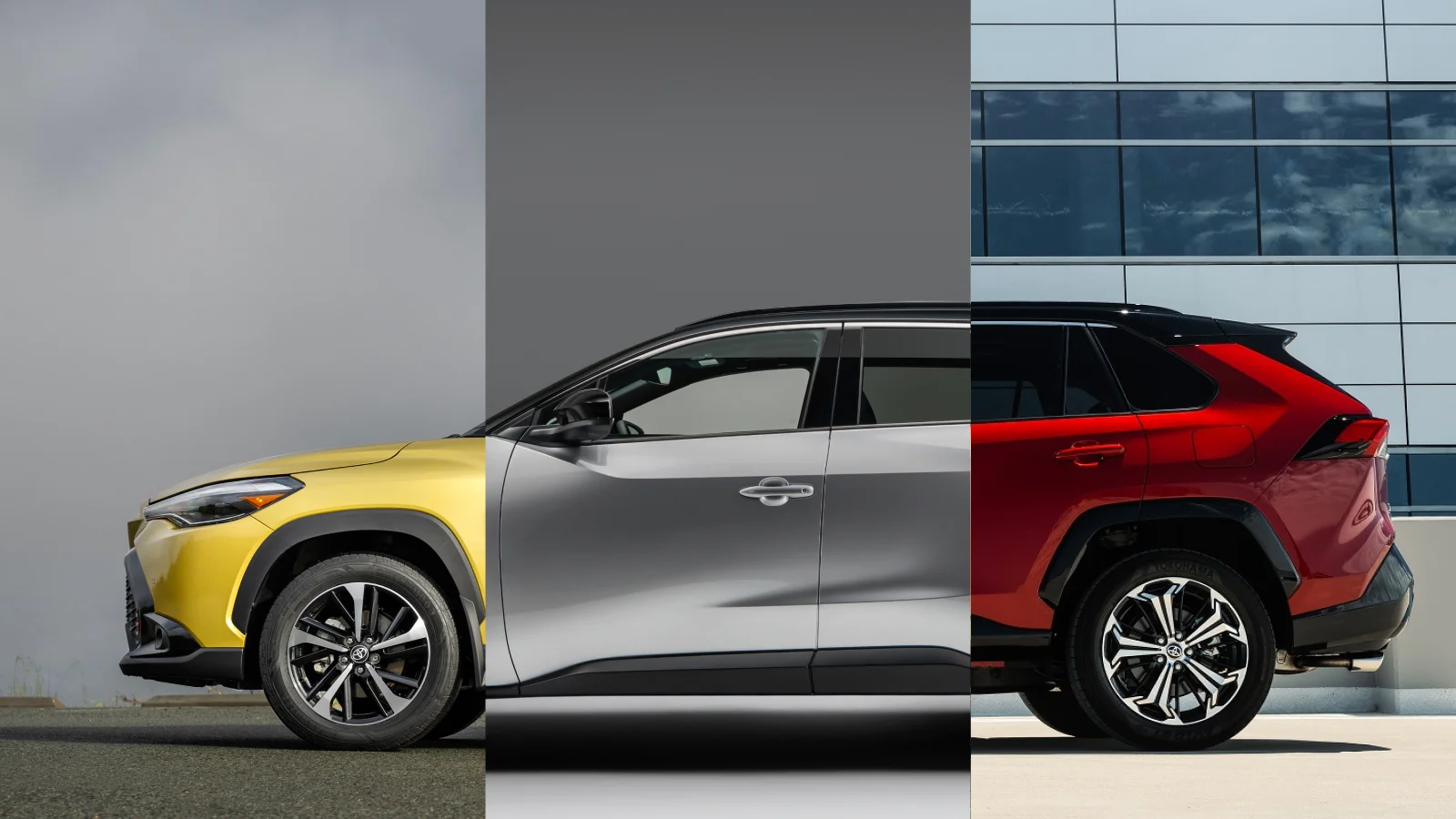How Does an EV Drive?
If you’ve ever wondered what an electrified vehicle drives like, the answer is that it depends.
Different types of electrified vehicles offer very different driving experiences. If you’re trying to decide between a hybrid electric vehicle (HEV), a plug-in hybrid electric vehicle (PHEV), or a battery-electric vehicle (BEV), each vehicle type provides a very different experience in acceleration, braking, and driving at different speeds.
It’s always best to experience each different type of vehicle firsthand though a test drive to help you determine which one is right for you. Here’s an overview of what to expect and experience when driving each type of electrified vehicle.

Hybrid Electric Vehicle (HEV)
Conventional hybrid-electric vehicles have been around for over 20 years, yet it’s surprising how many people haven’t driven or owned one. Hybrids were originally designed to help reduce fuel consumption of gas-powered vehicles, where their small electric motor(s) and battery essentially “assist” the gas engine.
All hybrids combine an internal combustion engine (ICE) with an electric motor(s). The most common hybrids, like the Toyota Prius and RAV4 hybrid, are called parallel-series hybrids since the gas engine and electric motor can be used in parallel to drive the wheels (e.g. either gas only or electric only) or in series (e.g. gas engine together with electric motor). When the battery is depleted, there’s no need to plug it in since the gas engine will charge the battery. The only fuel you need to use is gasoline.
When driving a hybrid, the first thing that you’ll likely notice is how similar it is to driving a conventional gas-powered vehicle. There are, however, some noticeable differences. Under ideal conditions and at low speeds under 25 miles per hour, most hybrids can run on electric-only power for a few miles. In stop and go city traffic and ideal conditions, you may notice that the gas engine will shut off to reduce fuel consumption at a standstill. When accelerating from a stop, most hybrids will start off in electric-only until more power is required, at which point the gas engine will start to run.
Conditions like speed, road conditions, weather, temperature, and how much energy remains in the battery may affect the vehicle’s capability of driving in electric-only power at any given time. At highway speeds, you’ll likely noticethat the gas engine is on all the time as it is the primary source of power and recharges the battery. You may also notice that when coasting on flat or downhill roads, the electric motor will come on to assist. With many modern hybrids the transition between gas and electric is usually seamless and determined by the vehicle’s computer.
When compared to battery-electric vehicles, hybrids don’t often provide instant acceleration. This is due to the hybrid’s small electric motor, small battery, and gas engine that is usually tuned for fuel efficiency. However, there are hybrids, like the Toyota Grand Highlander Hybrid MAX, that provide more power from a more powerful gas engine.
Like plug-in hybrids and battery-electric vehicles, hybrids also have regenerative braking – a feature that uses the electric motor to recharge the battery when braking. However, since hybrids have a much smaller battery and electric motor, you’ll notice that the amount of regenerative braking is much less than that of other electrified vehicles.
Driving a hybrid also means that you’re not searching for a charging station. You just need to fill it up like a regular gas-powered vehicle. This is why it’s most suitable for people who want to ease into electrification, need to drive longer distances, or live in more rural areas where it’s difficult to find a charging station.

Plug-in Hybrid Electric Vehicle (PHEV)
Plug-in hybrid vehicles are similar to conventional hybrids, with three key differences:
· Larger battery, often 10 times larger than that of a conventional hybrid
· More powerful electric motor(s)
· Ability to charge the battery through an external charger
There are two different types of plug-in hybrids. The most common is a parallel-series plug-in hybrid, such as a Toyota Prius Prime or RAV4 Prime, that operates like a conventional hybrid. Plug-in hybrids like the upcoming RAM Ramcharger REx, are series plug-in hybrids where the electric motor is the sole source of driving power. The gas engine is not used to drive the wheels and acts only as a generator to recharge the battery. Both types of plug-in hybrids can also be charged by using an external charger.
Driving a plug-in hybrid is very similar to driving a conventional hybrid. However, unlike a conventional hybrid, you’ll be able to drive on electric-only for up to 40 miles depending on the model. This is due to a plug-in hybrid’s larger electric motor and battery. Around town, you’ll notice that the engine may shut off during stop and go traffic just like a conventional hybrid. You’ll also be able to accelerate and drive longer distances in electric-only power.
Like conventional hybrids, the amount of electric-only power depends on speed, road conditions, weather, temperature, and how much energy remains in the battery. If you charge your plug-in hybrid each time, you can likely drive on electric power without needing the gas engine. Acceleration is similar to that of conventional hybrids but in EV mode plug-in hybrids can often provide you with more instant power due to their large battery and electric motor(s).
On the highway, most plug-in hybrids will operate primarily with the gas engine and use the electric motor to assist when needed. Regenerative braking is also more powerful since its larger electric motor is needed to charge the larger battery. Plug-in hybrids, like the Mitsubishi Outlander PHEV, allow you to choose different modes, such as “EV mode” for all-electric driving, “Save mode” to maintain a desired battery level, and “Charge mode” to prioritize charging the battery to full.
If you’re driving a series plug-in hybrid, like an older Chevrolet Volt or upcoming RAM Ramcharger REx, you’ll be able to drive on electric power all of the time. You may hear the gas engine turn on when the battery level is low and turn back off when charged. These type of plug-in hybrids drive like battery-electric vehicles, providing quick acceleration and stronger regenerative braking.
Plug-in hybrids are suitable for people who are not ready to go full electric, but want to experience full electric motoring without worrying about range or charging. While you don’t technically need to charge these vehicles, you’ll save more money on gas by doing so. Like conventional hybrids, these are best suited for people who drive longer distances and live in rural areas where charging is difficult to find.

Battery-Electric Vehicle (BEV)
Battery-electric vehicles are only powered by an electric motor(s) and a large battery. The absence of a gas engine means that you’ll be able to experience full electric-only motoring 100% of the time. Charging occurs through Level 1, 2, or 3 DC fast charging and most modern battery-electrics provide at least 250 miles of range.
Driving a battery-electric is truly a very different experience than driving a conventional hybrid or plug-in hybrid. The most noticeable characteristic is full instant power and torque when you press the accelerator. Even the least powerful battery-electrics have quicker acceleration than many gas powered, hybrid-electric, or plug-in hybrid electric vehicles. In fact, many battery-electrics, like the Tesla Model S Plaid, provide acceleration comparable to many exotic gas-powered supercars.
Because there’s no gas engine running, you’ll experience extremely smooth and quiet driving at any speed. Acceleration, cruising, and even idling is significantly quiet. Regenerative braking is noticeable stronger than hybrids and plug-in hybrids since the larger electric motor(s) generate more electricity to charge the larger battery. Battery-electrics also provide true one-pedal driving, where you can operate the vehicle with only the accelerator pedal. Gradual braking and coming to a complete stop are made possible through the stronger regenerative braking.
Battery-electrics are more suitable for people who want the full electric experience and want the benefit of completely eliminating gasoline costs as well as reducing maintenance costs. If most of your driving is done around town or during short commutes, battery-electrics offer more than sufficient transportation.
What EV Is Best For Me?
Not all electrified vehicles drive the same. Conventional hybrids, plug-in hybrids, and battery-electric vehicles all drive differently from one another. Battery-electric vehicles offer an unparalleled 100% gas-free motoring experience. Plug-in hybrids and conventional hybrids offer the experience of both worlds for those not ready to go full-electric. The best way to determine which type of electrified vehicle is right for you is to go out and test drive each one. Regardless of which electrified vehicle you choose, you’ll be joining the millions of Americans embracing electric motoring.













